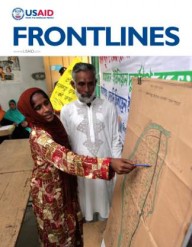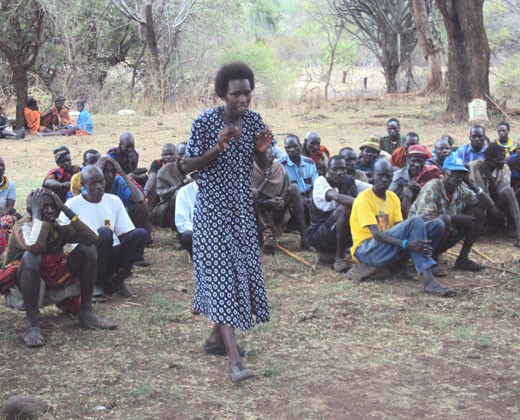 A peace committee member speaks to a group about early marriage and education for girls in Napak district.
IRC
View More Photos
A peace committee member speaks to a group about early marriage and education for girls in Napak district.
IRC
View More Photos
 A peace committee member speaks to a group about early marriage and education for girls in Napak district.
IRC
View More Photos
A peace committee member speaks to a group about early marriage and education for girls in Napak district.
IRC
View More Photos
Instead of prepping community males for a cattle raid on a neighboring clan, women living in the Karamoja region of northern Uganda are learning a different set of skills.
Related Content
Having been both victims and perpetrators of violence in this region—a hotbed for livestock raids from Kenya and Sudan, and inter-district and inter-ethnic clashes—Karamoja’s women are acquiring the leadership and negotiation acumen to break the cycle of violence that has plagued their community for decades.
The USAID Women Building Peace Project, which began in 2010, takes advantage of the outsized influence of women and girls within their communities, and tries to channel this influence into a positive force.
While men are the key actors in the theater of violence, women traditionally encourage male members of their households and clans to engage in livestock rustling to enhance family status. Livestock is a symbol of wealth in Karamoja, an area where other economic opportunities are limited. It is also the primary dowry commodity, sometimes involving 50 to 100 heads of cattle.
Women perform rituals designed to bless men before raids and to ensure their safe return home. They also prepare the food for the men to eat while on their theft missions.
But there’s evidence that these women can transform into a force for good.
“When I first went to Karamoja in 2009, I was amazed to learn of how powerful women are or can be in their households and communities,” said Brenda Engola, governance and peacebuilding coordinator at the project’s implementer, International Rescue Committee (IRC). “I vividly recall a discussion with male community members who said they could not steal or raid animals if their wives or mothers told them not to. I also later learned that, in the past, it was considered a taboo to harm women in any way during raids. Such is the reverence attached to women.
“It is probably not surprising that when the International Rescue Committee carried out a formal assessment in five districts of Karamoja later the same year, most community members said that women are powerful agents of change and can use this power to mitigate conflict and promote peace.”
Ending the persistent violence in Karamoja, in volatile East Africa, continues to be of strategic importance to the United States. Using women in peacebuilding provides a new and valuable direction towards achieving peace in the region. It is, says Rex Achilla, a community leader from Moroto district, “an important in-road in breaking the cycle of violence that persists in Karamoja” since women “provide the lubricant that oils the conflict. … Mothers can easily stop their sons from going to war. They can, in confidence, easily engage their sons and husbands in dialogue.”
Women Find Their Voice
The Agency is working in 15 parishes in Moroto and Napak districts of Karamoja region—the two poorest districts in Uganda—to reduce the risk of conflict by teaching women to be agents of peace.
So far, organizers have held more than 450 public discussions reaching over 10,000 people. The project also has supported 15 inter-clan peace dialogues, which were convened after peace committees and community leaders determined that conflict was imminent.
The project has established eight peace committees, each containing 30 members, a third of them women. The self-selecting committees represent three ethnic groups and meet at least once a month to analyze conflict and draw up prevention and response action plans. At present, 20 percent of the key committee positions are held by women.
Each committee acts as a safe space for inter-clan peace dialogues and meetings, which is crucial in a region with 10 ethnic groups that frequently clash over status and wealth, as well as resources like pasture lands and water points for cattle.
In addition to the committees, the project builds women’s skills in communications, decision making and power dynamics. It encourages women to gather in a central location at least once every quarter and delivers skills trainings in nga’karimojong, the local language spoken in Karamoja.
“Most of these women have come a long way,” says Israel Opolot, one of the IRC’s peacebuilding officers. “At the start of the project, they were shy to speak out. We had to strengthen the use of animation in the trainings to build their confidence and help them explore their limits. Today, they are enthusiastic. They request refresher trainings and are proud to share stories of how they are putting their newly acquired skills to use.”
“As a woman, I never attended any meetings in the community before the Women Building Peace Project trainings,” said Vicky Iriama, a sub-county leader in Napak district. “I now have confidence that women in the community can influence positive change, unlike in previous times when men were the sole decision-makers for the family—good or bad. In my family, for example, I have influenced my husband to construct a latrine and help me with my chores.”
A NATIONAL PLAN FOR WOMEN PEACEBUILDERS
In December 2011, the United States Government released its National Action Plan on Women, Peace, and Security, laying out commitments to empower women across the globe to be equal partners in peacebuilding, peacemaking and rebuilding their societies.
Through this plan and the accompanying executive order, President Barack Obama directed the U.S. Government to accelerate, institutionalize and better coordinate efforts to advance women's inclusion in preventing conflict and building peace in countries threatened and affected by war, violence and insecurity.
Drawing on its extensive work in crisis and conflict-torn regions, USAID soon after released its own plan[pdf 6.5mb] to implement the government-wide initiative. The Agency is today supporting key objectives in the National Action Plan with new programs—such as the peacebuilding program in northern Uganda and new activities in Yemen, Nepal and the Philippines—to promote women's participation in peace processes and political transitions and to keep them safe in situations of crisis and conflict.
Swearing Off Rituals
In the more than two years since the project’s inception, women have extended their influence outside their homes to communities. They keenly observe the actions of their husbands, sons and other male members of their homesteads to recognize signs of impending conflicts with other clans. Unlike in the past, they are now taking bold steps to prevent such conflicts or the escalation of existing conflicts.
In May 2012, for example, the female members of the Matheniko peace committee took the unprecedented initiative to convene an advocacy dialogue in Moroto district. They were concerned that the conflict involving the Matheniko and Tepeth clans in Uganda and the Turkana clan in Kenya would escalate.
They quickly and successfully mobilized their leaders—fellow women, men and youth—to participate in a vibrant discussion to prevent intensification. The discussion expedited security deployment along Uganda’s international border with Kenya and formed the basis of joint peace efforts with women from Turkana in Kenya.
The women expressed determination to work collectively and expose any attempts by men to perpetuate conflict. They swore not to perform any traditional rituals to bless such attempts. Together with the Government of Uganda security interventions, their efforts diffused the tensions involving the Matheniko, Tepeth and Turkana clans.
“It is enormously rewarding to see the increased focus on women as change agents and peacebuilders paying off. The work underway
in Uganda is a perfect example of how women can use their traditional authority to help groups avoid conflict. It also speaks to how these efforts can enhance family and community well-being in multiple ways. The Women Building Peace Project is just one example of how USAID’s work is evolving positively as a result of the greater focus on women's empowerment and women, peace and security,” said Carla Koppell, USAID’s senior coordinator for gender equality and women’s empowerment.
Veronica Achok, a peace committee member in Moroto district, says the project changed her outlook: “I had wealthy parents who did not value my schooling but looked at me as a source of wealth when married. I was forced to marry against my wishes at a very young age to a man I did not like. I lived miserably until one day… [I got] involved in peacebuilding activities; I could move from one place to another attending dialogues and peace talks … [and we women began] to engage with men on issues of common good.
“I started to practically implement what I had learned through talking with my husband. It was not an easy task at first as he threatened to stop me from attending project activities. But with my persistence and perseverance, I was able to win him over to the extent that we now attend project activities together and live in harmony.”
WHERE DISARMAMENT AND DEVELOPMENT MEET
The Karamojong people of Uganda are pastoralists whose livelihoods are affected by environmental issues, insecurity, poor health and lack of infrastructure. Cyclical droughts have increased food insecurity for a majority of the Karamojong. The districts of Karamoja have the highest rates of poverty in Uganda due to poor harvests, cattle raiding and insecurity, as well as harmful gender-related traditional practices such as early marriage and payment of bride price.
Several years ago, the Government of Uganda launched the large-scale Karamoja Integrated Disarmament and Development Program to address the unique development challenges in the Karamoja region. With a multipronged approach to development, program elements include education and literacy, agricultural production, water and sanitation, health-care access, infrastructure, livelihoods and rule of law.
Following remarkable achievements in disarmament in the area, the name was adjusted accordingly in 2011. USAID supports the Karamoja Integrated Development Program through food security, agricultural livelihoods, health systems strengthening, and activities for orphans and vulnerable children.











Comment
Make a general inquiry or suggest an improvement.